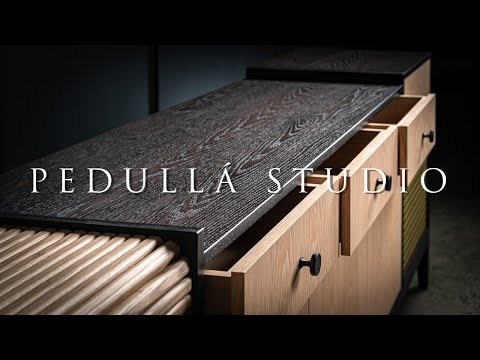WOODWORKING – Building an Oak Cabinet with a Sliding Tambour Door
4 min read
Want to know more about how I built this piece? Check out my Patreon Page – https://www.patreon.com/pedullastudio
Follow along as I build this Black Stained Oak and Brass Record Cabinet which features a Sliding Wooden Tambour Door, Brass Grilles, and a Push to Open Sliding Bi-Fold Door, all designed to stylishly house my clients record player as well as a large collection of records. Other equipment such as the amplifier sit behind the brass grilles. (Please note the crappy record player shown is not my clients, its just the one I have in my workshop)
It’s important to understand that when building a piece as detailed and precise as this you must allow the wood to acclimate properly to your shop as well as let it adjust to its new state after the milling process.
I never show the extensive milling process I go through but each board is gradually taken down to it’s final size in a series of stages, allowing the boards to rest in between. In particular, the slats for the Tambour door, which have been milled repeatedly over a week and a half, gradually bringing them down to the finished size. This process allows as much movement as possible to escape before assembly.
The Tambour Door uses a canvas glued to the back of the wooden slats. I’ve used contact glue to do this which can have its problems if not done correctly. Please note not all contact glues are the same. I only ever use industrial grade contact glue sourced from my suppliers. I never use glue from general hardware stores, from my experience it doesn’t hold up as well. I would not use PVA as this will introduce moisture back into your wooden slats.
When I originally designed the Tambour door I hand carved a handle into one of the wooden slats (shown in parts of the video). Once everything was assembled I decided I didn’t like the style of handle and cut it off, then replaced it with a smaller handle which has been rebated into the slats.
The Push to Open Sliding Bi-Fold Door. Seems simple enough right? But there is a lot more going on here than meets the eye.
In order for a sliding bifold door to work, there needs to be a track that guides the door from its open position to its closed position.
In order for a push to open mechanism to work, the mechanism itself needs to push past the door enough to pop the door open.
Can you see the problem here?
The push to open mechanism, when open, blocks the path of the sliding door.
Now to be honest, when I designed this Record Cabinet I just assumed there was some hardware that existed that could achieve this, but to my surprise I couldn’t find anything for a small cabinet like this, so I had to come up with my own solution.
I achieved this by adding a push block on the inside of the door. The block allows the push mechanism to fully spring open without interfering with the sliding door track.
Now because the push block protrudes so far out, I’ve had to make a slight recess in the opposite door to allow the bi-fold to open further.
The black stain used is just a cheap brand here in Australia called Feast Watson. There’s nothing special about it other than the fact that it is oil based. I’ve use this stain because I like how the light oak undertones come through the black. If I was going for a deep black I would’ve picked another product.
My process for applying black stain is to finish sand everything to 120 grit by hand then apply three coats, letting the stain sit for a couple of minutes before wiping off the excess. Sanding to 120 grit allows more stain to penetrate the wood.
I used Osmo Poly X oil as a clear topcoat which isn’t usually recommended as it can remove some of the colouring from Feast Watson products, but I have allowed the stain to cure for over a week before applying the topcoat.
All my custom-made aluminium hardware has been sprayed black to suit the rest of the cabinet. All other hardware is by Blum.
The Tools & Equipment I use- https://kit.co/nickpedulla
For weekly updates- https://www.instagram.com/pedullastudio/
Standard Questions-
– What glue do I use? Titebond 3
– What finish do I use? Osmo Oil satin
– What stain is that? Feast Watson Prooftint- Black
100,000 Subscribers! Thats unbelievable! Thank you to everyone who watches my videos. I truly appreciate the support, and if you haven’t already, please like, share and subscribe as that will really help my channel to grow.
Designed, built, filmed and edited by Nick Pedulla from Pedulla Studio
Music from https://www.epidemicsound.com
#woodworking #recordcabinet #tambourdoor
FOLLOW HERE:
Website- http://www.pedullastudio.com.au
Instagram- https://www.instagram.com/pedullastudio/
Facebook- https://www.facebook.com/pedullastudio/
Gear I Use- https://kit.co/nickpedulla



